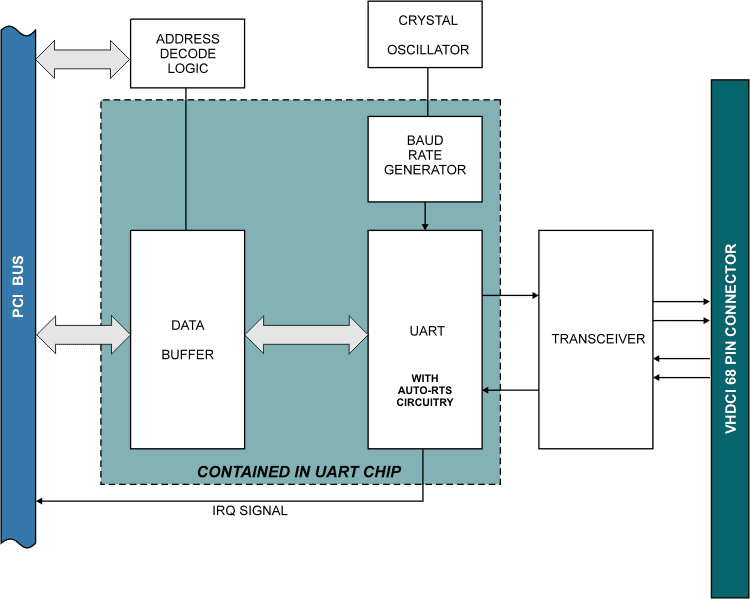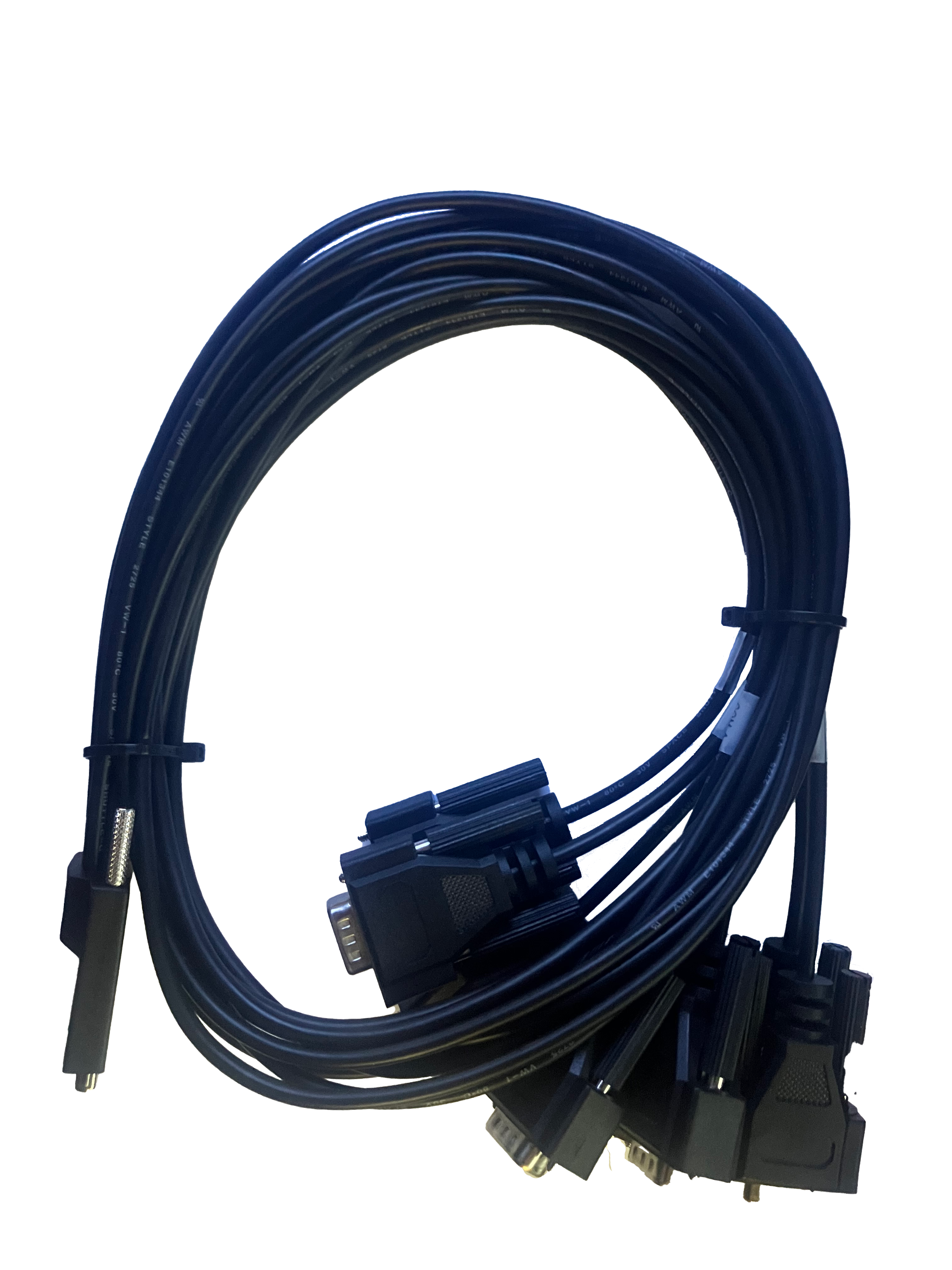LPCI-COM-8SM Multiprotocol Family Serial Cards
Features
- Eight or four-port Universal PCI serial communication card
- Supports field selectable RS-232, RS-422 or RS-485 (2-wire and 4-wire) protocols
- Includes type 16L788 octal UART with 64-Byte FIFO buffers in all modes
- Speeds up to 921kbps
- Meets MD2 Low Profile PCI Bus Specification
- Universal PCI, PCI-X, 3.3V and 5V compatible (Call for PCI-Express availability)
- Includes cable (no external breakout box required)
- RS-232 only versions also available
- Designed, made, supported, and manufactured in the USA
- Support for Wind River VxWorks (call for ordering information)
Price range: $319.00 through $739.00
In StockDescription
Universal PCI, Eight or Four-port RS-232/422/485 Serial Communication Card (In a Low Profile form factor)
The LPCI-COM Series are eight or four-port asynchronous serial communication cards designed for use in PCI bus computers. The cards support RS-232, RS-422, and/or RS-485 communications which can be selected on a port by port basis. The cards are 6.6 inches in length and 2.21 inches seated height and may be installed in any 3.3 or 5-volt PCI or PCI-X expansion slot. A regular profile mounting bracket is installed for use in standard size computers, while a low profile bracket is provided for low profile computers (such as thin-client and high-density rack-mount servers). The cards are supplied with an eight-connector DB-9 breakout cable (no external breakout box required). The LPCI line has been designed for use in retail, hospitality, postal automation, and POS system applications and industries such as gaming and defense where space is a valuable resource.
A type 16L788 octal UART is used as the asynchronous communication element. This includes 64-byte transmit/receive FIFO buffers to protect against lost data in multitasking systems while maintaining compatibility with the original IBM serial port (100% compatible with standard Windows COM port drivers).
Crystal oscillators located on the card permit precise baud rate capability up to 115,200. Higher speeds, up to 921k baud, are achieved by changing a jumper on the card. The driver/receivers used for RS-485 & RS-422 are type SP491, and are capable of driving long communication lines at high baud rates. They can drive up to ±60 mA on balanced lines and receive inputs as low as 200 mV differential signal superimposed on common mode noise of +12V to -7V. In case of communication conflict, the driver/receivers feature thermal shutdown.
AUTO TRANSCEIVER CONTROL
In RS485 communications, the driver must be enabled and disabled as needed, allowing all devices to share a two wire cable. The card can control the driver automatically. With automatic control, the driver is enabled when data is ready to be transmitted. At default the driver remains enabled during transmission and is adjustable up to one additional character’s transmission time after data transfer is complete and then is disabled. The receiver is also normally enabled, then disabled during RS485 transmissions, and then re-enabled after transmission is completed (plus up to one character transmission time). The card automatically adjusts it’s timing to the baud rate of the data. (NOTE: Thanks to the automatic control feature, the card is ideal for use in Windows and Linux applications)
UTILITY SOFTWARE
A complete driver support package is provided including an easy to use Windows terminal program for testing out your COM ports. This helps simplify verification of proper operation. The card installs as standard Windows COM ports in all Windows operating systems. The card is supported by most operating systems and includes a free DOS, Linux and XP -> 10, both 32 & 64 bit compatible software package. This includes sample programs and source code in “C” for DOS, and Visual Basic, Delphi, and Visual C++ for Windows. Also included is a graphical setup program in Windows.
Modified-COTS (MCOTS) Customization
ACCES can tailor any standard product to your precise requirements — electrical, mechanical, firmware, environmental, or connector-level. Common MCOTS options include alternate I/O ranges, isolation enhancements, firmware changes, private labeling, conformal coating, extended temperature operation, ruggedized enclosures, and military-grade components. If this product is close but not a perfect fit, our engineering team can deliver a rapid-turn MCOTS variant with minimal NRE and dependable, Made-in-USA quality.
Downloads
Manuals
Software
- LPCI-COM Family Software Package ( -- Last Uploaded 2025-05-07)
Drivers and Downloads
Full list of available Downloads: Software Packages, Drivers, Manuals, and other documents
Information about our Free Software packages:
ACCES is proud to provide a full suite of software support with every Data Acquisition product. We are committed to supporting the most popular operating systems and platforms for our customers. Currently we are actively supporting 7 -> 11, both 32 & 64 bit, including “Server 2008,” “Embedded,” and “Compact” flavors for all plug-and-play products including PCI, PCI Express, USB, and more. Many products continue to ship with support for additional operating systems such as DOS, Windows 95, 98, Me, NT4, 2000, and XP.
Samples
Among the software we deliver with our products are sample programs in a wide variety of programming languages. These samples are used to demonstrate the software interfaces to our products — and many can be used as-is in your production environments, or to test functionality of the devices out-of-the-box. We’re currently actively supporting sample programs in Microsoft Visual C#, and Delphi, with many devices including samples in Visual Basic (5 and .NET), Visual C/C++, and Borland C/C++ 3.1 for DOS. Additionally we provide National Instruments LabVIEW compatible DLLs and many demonstration VIs for our devices.
Drivers
Drivers for various operating systems are also provided, including active support for Windows 7 -> 11 — all in both 32-bit and 64-bit flavors, and including consumer, server, and embedded varieties — as well as the 2.6 and newer Linux kernels and recent OSX / macOS versions. Many products continue to ship with driver support for Windows 95, 98, Me, NT4, Windows 2000, XP, and more, but support for these operating systems is considered deprecated.
Setup Programs and Utilities
Our Data Acquisition devices also include a graphical setup utility that walks you through the process of configuring any option jumpers or switches on the device, as well as explaining a little about the various connectors present.
Many devices also include utility programs – little tools to make your use of the device easier, such as EWriter, a program that allows you to read and write data in the user-accessible EEPROM locations on all our USB data acquisition products; or WinRISC, a “Really Incredibly Simple Communications” terminal program that lets you get started instantly with serial devices.
“Register Level” Documentation
Besides all this software in all these languages and operating systems ACCES has a policy of open and transparent development: none of our lowest-level “register” interfaces are hidden from you — we document every register in every bus card, every command in every serial board, and every usb control transfer in every USB Data Acquisition board. These lowest-level interfaces allow you to develop for our products in ANY operating system or language, regardless of our actively supporting it or having a driver for it. We have customers actively developing in ADA, Android, Python, Java, MATLAB, Solaris, and more, just by referring to our complete low-level interface documentation! And we provide the full source code to all of our drivers, regardless of operating system, to give you an even bigger head start in your own development tasks.
No Fees or Royalties
All of this software is provided at no additional charge, and is licensed under any of a variety of flexible — and royalty free — options. Check out our software license explanation if you’d like more information.
Custom Software
ACCES also offers Custom Software Services for our products. Our prices are unbelievably low, often as inexpensive as free! If you need something tweaked to support your needs, or an entire enterprise application developed from scratch, it is definitely worth your time to inquire with us, first.
Further information about available ACCES Software:
Redistributing Windows Drivers
A list of ACCES drivers and the files that compose them under different versions of Windows, so you can easily redistribute ACCES cards and drivers.
AIOSerial/VxWorks
ACCES has successfully partnered with Wind River to bring our entire line of PCI and PCI Express Serial Communication cards to VxWorks 7! All ACCES plug-and-play serial cards are now supported with our VxWorks driver, including RS232, RS422, RS485 (2- and 4-wire) and baud rates up to 10Mbps.
Designed as an update to the existing vxbPciNs16550Sio.c driver, we’ve added support for ×8 baud rates, proper handling of the unique register location of the 4th port in the Pericom PI7C9X7954 UART, and configuring the serial protocol from your application software.
With this driver suite all ACCES PCI, PCI Express, PCI Express Mini Card, M.2, PCI-104, PCIe/104, and all related “PCI Style” plug-and-play serial cards will detect and install as standard VxWorks SIO ports.

Communications Interface
- I/O Connections: Via a 68-pin, shielded, VHDCI connector. There are 9 pins per port including common grounds. All RS-232 signals are supported and present at the DB-9 connectors
- Cable: Breakout Cable from VHDCI Connector is secured to card using jack screws, with a DB9 connectors provided for each port.
- Character Length: 5,6,7, or 8 bits.
- Parity: Even, odd, or none.
- Stop Interval: 1, 1.5, or 2 bits.
- Serial Data Rates: Up to 115,200 baud, asynchronous. A faster range of rates, up to 921k baud, is achieved by jumper selection on the card prior to installation.
- Multidrop: Compatible with RS-485 specifications. Up to 32 drivers and receivers allowed on line. Driver/Receivers used are type SP491.
- Rec.Input Sensitivity: ±200 mV differential input.
- Common Mode Voltage Range: +12V to -7V.
- Transmitter Output Drive Capability: 60 mA with thermal shutdown.
Environmental
- Operating Temperature Range: 0 to +60OC.
- Storage Temperature Range: -50 to +120OC.
- Humidity: 5% to 95% RH, non-condensing.
- Power Required: +5 VDC at 200 mA typical, 1300 mW total power consumption.
- Size: 6.6″ long (167.64mm) by 2.21″ tall (56.17mm) seated height.
Regulatory Compliance
- This product is in full compliance with CE requirements.
| Model | Description | Price (USD) | |
|---|---|---|---|
| LPCI-COM232-4 | Universal PCI, Four-port RS-232 Serial Communication Card (In a Low Profile form factor) | $319.00 | |
| LPCI-COM232-8 | Universal PCI, Eight-port RS-232 Serial Communication Card (In a Low Profile form factor) | $469.00 | |
| LPCI-COM-4SM | Universal PCI, Four-port RS-232/422/485 Serial Communication Card (In a Low Profile form factor) | $454.00 | |
| LPCI-COM-8SM | Universal PCI, Eight-port RS-232/422/485 Serial Communication Card (In a Low Profile form factor) | $739.00 |


